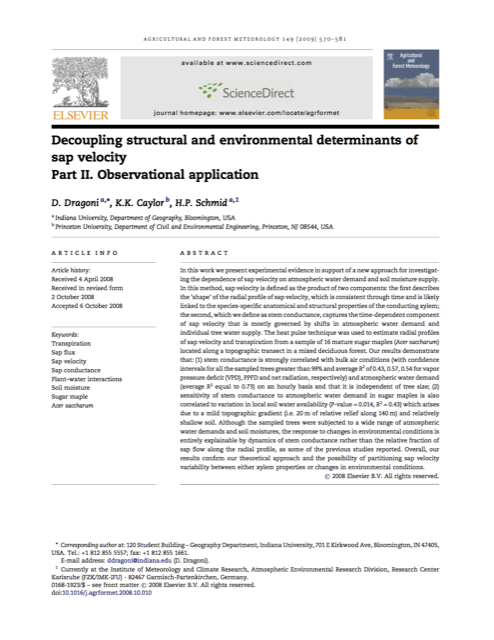Decoupling structural and environmental determinants of sap velocity: Part II, Observational application

Dragoni, D., K.K. Caylor, and H. Schmid (2009) “Decoupling structural and environmental determinants of sap velocity: Part II, Observational application,” Agricultural and Forest Meteorology, doi:10.1016/j.agrformet.2008.10.010.
In this work we present experimental evidence in support of a new approach for investigating the dependence of sap velocity on atmospheric water demand and soil moisture supply. In this method, sap velocity is defined as the product of two components: the first describes the ‘shape’ of the radial profile of sap velocity, which is consistent through time and is likely linked to the species-specific anatomical and structural properties of the conducting xylem; the second, which we define as stem conductance, captures the time-dependent component of sap velocity that is mostly governed by shifts in atmospheric water demand and individual tree water supply. The heat pulse technique was used to estimate radial profiles of sap velocity and transpiration from a sample of 16 mature sugar maples (Acer saccharum) located along a topographic transect in a mixed deciduous forest. Our results demonstrate that: (1) stem conductance is strongly correlated with bulk air conditions (with confidence intervals for all the sampled trees greater than 99% and average R2 of 0.43, 0.57, 0.54 for vapor pressure deficit (VPD), PPFD and net radiation, respectively) and atmospheric water demand (average R2 equal to 0.73) on an hourly basis and that it is independent of tree size; (2) sensitivity of stem conductance to atmospheric water demand in sugar maples is also correlated to variation in local soil water availability (P-value = 0.014, R2 = 0.43) which arises due to a mild topographic gradient (i.e. 20 m of relative relief along 140 m) and relatively shallow soil. Although the sampled trees were subjected to a wide range of atmospheric water demands and soil moistures, the response to changes in environmental conditions is entirely explainable by dynamics of stem conductance rather than the relative fraction of sap flow along the radial profile, as some of the previous studies reported. Overall, our results confirm our theoretical approach and the possibility of partitioning sap velocity variability between either xylem properties or changes in environmental conditions.
